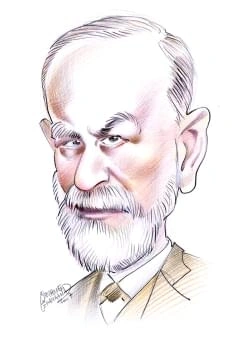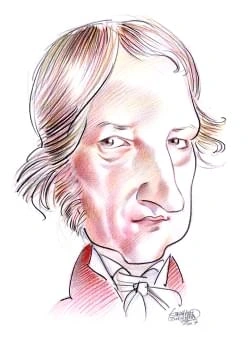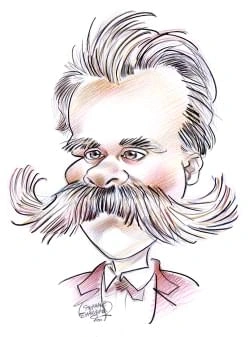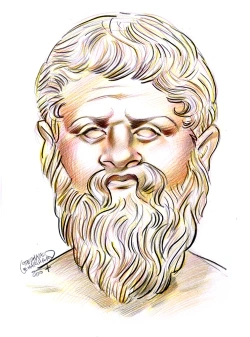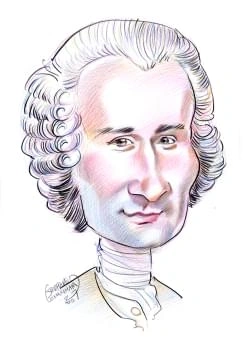319 résultats pour "economy"
-
Qin Dynasty - History.
measurements. All of these contributed greatly to the Qin's new centralized economy. C Government The Qin government was totalitarian, based on the philosophy of Fajia (Legalism), which placed absolute power in the hands of the ruler, who governed by means of strict laws and harsh punishments. Practical reformers and scholars such as Shang Yang (d. 338 BC) and Han Fei (280?-233 BC) saw Legalism as a way to create a highly efficient, albeit ruthless, administrative apparatus. Qin Shihuangdi...
-
San Jose (California) - geography.
The San Jose metropolitan area is an economic powerhouse. It is the single most important high-technology center in the United States, specializing in aerospace andcomputer technology. Assisting in the area’s steady innovation is its many venture capital firms, which loan money to entrepreneurs starting new companies. It isestimated that the region contains one-half of the leading venture capital firms in the world. Among the nation’s largest companies in the San Jose metropolitan regionare Inte...
-
United States History - U.
and improved upon the designs of Arab sailing ships and learned to mount cannons on those ships. In the 15th century they began exploring the west coast ofAfrica—bypassing Arab merchants to trade directly for African gold and slaves. They also colonized the Madeira Islands, the Azores, and the Cape Verde Islands andturned them into the first European slave plantations. The European explorers were all looking for an ocean route to Asia. Christopher Columbus sailed for the monarchs of Spain in 149...
-
United States History - U.
and improved upon the designs of Arab sailing ships and learned to mount cannons on those ships. In the 15th century they began exploring the west coast ofAfrica—bypassing Arab merchants to trade directly for African gold and slaves. They also colonized the Madeira Islands, the Azores, and the Cape Verde Islands andturned them into the first European slave plantations. The European explorers were all looking for an ocean route to Asia. Christopher Columbus sailed for the monarchs of Spain in 149...
-
Guatemala - country.
C Climate The climate of Guatemala varies according to elevation, from hot coastal plains to cold mountain heights. Most of the population lives between 900 and 2,400 m (3,000and 8,000 ft) above sea level, where there are warm days and cool nights with average annual temperatures of 20°C (68°F). The coastal regions are hot and humid,with average annual temperatures of 28°C (83°F). A rainy season, from May through October, is sometimes called “winter” because it brings cloudy afternoons andlower...
-
Nunavut - Canadian History.
The Arctic Lands is a complex geological area that is centered on the Arctic Ocean. It includes coastal plains, plateaus, and mountains. Coastal plains and plateaus arefound in the western Northwest Territories section of the Arctic Lands, such as on Victoria Island, which is mostly a large, flat plateau. In striking contrast to theserelatively gentle landscapes, the eastern Nunavut section of the Arctic Lands is dominated by a jagged chain of ice-covered mountains. The mountains on EllesmereIsl...
-
Iraq - country.
The Euphrates begins in Turkey, crosses Syria, and enters Iraq at Abū Kam āl. The flow of the Euphrates into Iraq has been greatly reduced by dams built by Turkeyand Syria. The gradient of the Euphrates above the town of H īt, in west central Iraq, is steep. In the 2,640 km (1,640 mi) from its source in Turkey to H īt, the river fallsfrom 3,000 m (10,000 ft) to a low water elevation of 50 m (170 ft) above sea level, an average drop of 1 m per km (6 ft per mi). In Iraq below H īt the fall is very...
-
Jakarta - geography.
voluntary movement of families to Indonesia's less populated islands). Jakarta is a magnet for migrants from other areas of Indonesia; during the late 1980s an estimated 250 migrants arrived daily. Most were between the ages of 15 and39 years, many with six years of education or less. There is also a significant number of commuters and seasonal migrants who work in government, manufacturing,and services. In addition, many of these temporary residents are engaged in informal employment as drivers...
-
-
Spain - country.
B Natural Resources Spain has a number of mineral resources. The largest known deposits are of iron ore, zinc, and lead. Spain also produces significant quantities of copper and mercury.These deposits are mined mainly in Huelva province in southwestern Spain, around Cartagena on the Mediterranean, and at various points along the Bay of Biscay inthe north. Additionally, uranium is mined in the region of Extremadura, near the Portuguese frontier, where pyrites, fluorspar, gypsum, tungsten, and po...
-
Texas - geography.
D Climate Eastern Texas has a humid subtropical climate, while a semiarid low latitude climate prevails in central areas, and an arid low latitude climate in the extreme west. Alongthe coast the climate is much milder, with fewer extremes in temperatures. Hurricanes sometimes hit the coastal areas of Texas from late July through September, andtornadoes are common in north-central Texas in April and May. D1 Temperature Summers are hot throughout the state, and temperatures exceeding 35°C (95°F)...
-
Texas - USA History.
D Climate Eastern Texas has a humid subtropical climate, while a semiarid low latitude climate prevails in central areas, and an arid low latitude climate in the extreme west. Alongthe coast the climate is much milder, with fewer extremes in temperatures. Hurricanes sometimes hit the coastal areas of Texas from late July through September, andtornadoes are common in north-central Texas in April and May. D1 Temperature Summers are hot throughout the state, and temperatures exceeding 35°C (95°F)...
-
Inuit.
VII HOUSING, TRANSPORTATION, AND CLOTHING Inuit homes are of two kinds: walrus or sealskin tents for summer and huts or houses for winter. Winter houses are usually made of stone, with a driftwood orwhalebone frame, chinked and covered with moss or sod. The entrance is a long, narrow passage just high enough to admit a person crawling on hands and knees.During long journeys some Canadian Inuit build igloos, winter houses of snow blocks piled in a dome shape (the term igloo comes from the I...
-
Georgia (state) - geography.
B Rivers and Lakes Most of the rivers of Georgia drain eastward to the Atlantic Ocean proper or southward to the Gulf of Mexico. Only a few flow northward to the Tennessee River, which isa major tributary of the Mississippi River. Most of the rivers flowing to the coasts are navigable by barges and small craft as far upstream as the Fall Line. The major river flowing to the Atlantic is the Savannah River, which, with the Tugaloo River, one of its headwaters, forms most of the state’s eastern bo...
-
Georgia (state) - USA History.
B Rivers and Lakes Most of the rivers of Georgia drain eastward to the Atlantic Ocean proper or southward to the Gulf of Mexico. Only a few flow northward to the Tennessee River, which isa major tributary of the Mississippi River. Most of the rivers flowing to the coasts are navigable by barges and small craft as far upstream as the Fall Line. The major river flowing to the Atlantic is the Savannah River, which, with the Tugaloo River, one of its headwaters, forms most of the state’s eastern bo...
-
Northwest Territories - Geography.
million years ago by the severe bending (folding) and faulting (breaking) of sedimentary rock that was once part of the Interior Plains. During the Wisconsin Ice Age,alpine glaciers covered the Cordillera, and the movement of the glaciers created razor-sharp peaks and ridges in these mountains. The moving glaciers also createdbroad U-shaped valleys. To the east of the Interior Plains, the ancient rocks of the Canadian Shield are exposed at the Earth’s surface, resulting in a rough, rolling terra...
-
Northwest Territories - Canadian History.
million years ago by the severe bending (folding) and faulting (breaking) of sedimentary rock that was once part of the Interior Plains. During the Wisconsin Ice Age,alpine glaciers covered the Cordillera, and the movement of the glaciers created razor-sharp peaks and ridges in these mountains. The moving glaciers also createdbroad U-shaped valleys. To the east of the Interior Plains, the ancient rocks of the Canadian Shield are exposed at the Earth’s surface, resulting in a rough, rolling terra...
-
-
Automation.
Not all industries require the same degree of automation. Agriculture, sales, and some service industries are difficult to automate. The agriculture industry may becomemore mechanized, especially in the processing and packaging of foods; however, in many service industries such as supermarkets, for example, a checkout countermay be automated and the shelves or supply bins must still be stocked by hand. Similarly, doctors may consult a computer to assist in diagnosis, but they must makethe final...
-
Maryland - geography.
Maryland has no large natural lakes. The largest body of water is a reservoir, Deep Creek Lake, which has a surface area of only 18 sq km (7 sq mi). It lies on theAllegheny Plateau, behind a dam on a tributary of the Youghiogheny River. C Coastline The deeply indented shoreline has a length of 5,134 km (3,190 mi), of which only 50 km (31 miles) fronts on the Atlantic Ocean. The most significant coastal feature isChesapeake Bay. In the bay are many islands and Kent Island is the largest. The sta...
-
Maryland - USA History.
Maryland has no large natural lakes. The largest body of water is a reservoir, Deep Creek Lake, which has a surface area of only 18 sq km (7 sq mi). It lies on theAllegheny Plateau, behind a dam on a tributary of the Youghiogheny River. C Coastline The deeply indented shoreline has a length of 5,134 km (3,190 mi), of which only 50 km (31 miles) fronts on the Atlantic Ocean. The most significant coastal feature isChesapeake Bay. In the bay are many islands and Kent Island is the largest. The sta...
-
Republic of Indonesia - country.
Mahakam in East Kalimantan and the Martapura and Barito in South Kalimantan. Most of these rivers originate in the island’s central massif (mountain mass) and meander through extensive swamps as they approach the coast. Settlements such as Samarinda and Banjarmasin cluster along the rivers, which serve ascommunication routes into the interior. The largest rivers on Sumatra drain from west to east into the Strait of Malacca. In the north, the Asahan River once linked trade between the Batak peo...
-
Ecuador - country.
F Natural Resources Ecuador’s main mineral wealth is in petroleum. Other mineral resources of the country include gold, silver, copper, lead, and zinc. Forests cover 38.3 percent of thecountry. G Plants and Animals Along the northern part of the Ecuador coast, and within the inner portion of the southern coast, tropical jungles abound. In some places the jungles extend up theslopes of the Andes as wet, mossy forests. Dense forests cover both flanks of the Cordilleras, as well as the Oriente, u...
-
Colorado - geography.
Although the rivers of Colorado are navigable only by small boats, they are important as a source of irrigation water for use in Colorado and adjoining states. However,the water level of the rivers fluctuates seasonally and from year to year. The level is generally low in winter and high in spring and summer, during the runoff of meltedsnow from the mountains. Colorado has no large lakes of natural origin, but there are numerous small lakes in the mountains. The largest bodies of water in Colora...
-
Colorado - USA History.
Although the rivers of Colorado are navigable only by small boats, they are important as a source of irrigation water for use in Colorado and adjoining states. However,the water level of the rivers fluctuates seasonally and from year to year. The level is generally low in winter and high in spring and summer, during the runoff of meltedsnow from the mountains. Colorado has no large lakes of natural origin, but there are numerous small lakes in the mountains. The largest bodies of water in Colora...
-
Lebanon (country) - country.
during the civil war. Within the country, thousands of Shia Muslim refugees fled fighting in southern Lebanon in the 1990s and moved into shantytowns in Beirut’ssouthern suburbs. Lebanon’s major cities were greatly affected by the civil war. Beirut has gradually regained most of its prewar population and remains the country’s largest city. Tripoli,the northern port, is the second largest city. Jūniyah, north of Beirut, was developed as a wartime port and subsequently had a population boom. Za ḩl...
-
-
Canada.
Six general landform regions are distinguishable in Canada: the Appalachian Region, the Great Lakes and St. Lawrence Lowlands, the Canadian Shield, the Great Plains,the Canadian Cordillera, and the Canadian Arctic Archipelago. B1 Appalachian Region and Great Lakes and St. Lawrence Lowlands Eastern Canada consists of the Appalachian Region and the Great Lakes and St. Lawrence Lowlands. The Appalachian Region embraces Newfoundland Island, NovaScotia, New Brunswick, Prince Edward Island, and the G...
-
Canada - country.
Six general landform regions are distinguishable in Canada: the Appalachian Region, the Great Lakes and St. Lawrence Lowlands, the Canadian Shield, the Great Plains,the Canadian Cordillera, and the Canadian Arctic Archipelago. B1 Appalachian Region and Great Lakes and St. Lawrence Lowlands Eastern Canada consists of the Appalachian Region and the Great Lakes and St. Lawrence Lowlands. The Appalachian Region embraces Newfoundland Island, NovaScotia, New Brunswick, Prince Edward Island, and the G...
-
Canada - Canadian History.
Six general landform regions are distinguishable in Canada: the Appalachian Region, the Great Lakes and St. Lawrence Lowlands, the Canadian Shield, the Great Plains,the Canadian Cordillera, and the Canadian Arctic Archipelago. B1 Appalachian Region and Great Lakes and St. Lawrence Lowlands Eastern Canada consists of the Appalachian Region and the Great Lakes and St. Lawrence Lowlands. The Appalachian Region embraces Newfoundland Island, NovaScotia, New Brunswick, Prince Edward Island, and the G...
-
Population.
year AD 1, and it took more than 1,500 years to reach the 500 million mark. Growth was not steady but was marked by oscillations dictated by climate, food supply, disease, and war. Starting in the 17th century, great advances in scientific knowledge, agriculture, industry, medicine, and social organization made possible rapid acceleration inpopulation growth. Machines gradually replaced human and animal labor. People slowly acquired the knowledge and means to control disease. By 1900 the worldp...
-
Estonia - country.
protest the expansion of open-pit phosphorite mining in northeastern Estonia. Their success in stopping the expansion prompted further demonstrations as part of thecountry’s independence movement. Since independence Estonia has taken measures to protect the environment. The government has ratified international agreementsto reduce emissions of hazardous wastes and greenhouse gases, as well as to protect biodiversity, wetlands, and endangered species. Estonians cherish thecountryside, and 31 perc...
-
Federal Republic of Germany - country.
B Rivers and Lakes Rivers have played a major role in Germany’s economic development. The Rhine River flows in a northwesterly direction from Switzerland through much of westernGermany and The Netherlands into the North Sea. It is a major European waterway and a pillar of commerce and trade. Its primary German tributaries include theMain, Mosel, Neckar, and Ruhr rivers. The Oder (Odra) River, along the border between Poland and Germany, runs northward and empties into the Baltic; it provides an...
-
India - country.
delta in the north, are intensely farmed. B Rivers and Lakes The rivers of India can be divided into three groups: the great Himalayan rivers of the north, the westward-flowing rivers of central India, and the eastward-flowingrivers of the Deccan Plateau and the rest of peninsular India. Only small portions of India’s rivers are navigable because of silting and the wide seasonal variation inwater flow (due to the monsoon climate). Water transport is thus of little importance in India. Barrages,...
-
Oregon - geography.
B Rivers and Lakes The Columbia River forms most of the Oregon-Washington boundary, and with its tributaries this great river drains a large portion of Oregon. From the point where theColumbia first touches the state, at Wallula Gap, the river runs in a shallow gorge, deepening as it approaches the Cascades. This part of the river once had manyrapids and falls, but is now navigable by large vessels because of dams and locks that have been built along much of its length. An important tributary o...
-
-
Oregon - USA History.
B Rivers and Lakes The Columbia River forms most of the Oregon-Washington boundary, and with its tributaries this great river drains a large portion of Oregon. From the point where theColumbia first touches the state, at Wallula Gap, the river runs in a shallow gorge, deepening as it approaches the Cascades. This part of the river once had manyrapids and falls, but is now navigable by large vessels because of dams and locks that have been built along much of its length. An important tributary o...
-
Greece - country.
minerals, such as chromium, copper, uranium, and magnesium, are relatively small. Greece’s small petroleum deposits, located under the Aegean Sea near the island ofThásos, are rapidly being depleted. There are no significant reserves of natural gas. Greece’s forests, probably abundant in ancient times, have been significantly depleted. Subsequent soil erosion has made reforestation efforts difficult. Although muchof Greece’s soil is rocky and dry, the country’s mountains are interspersed with sm...
-
Louis XIV
I
INTRODUCTION
Louis XIV (1638-1715), king of France (1643-1715), known as the Sun King.
he could defend against attack from his enemies. In the first instance, Louis worked to tighten central control over the array of departments, regions, and duchies that together made up France. To this end, he revivedthe use of regional intendants, officials who were sent to the provinces with instructions to establish order and effective royal justice. Although agents of the centralgovernment, intendants worked closely with the local nobility and legal institutions to establish efficient admini...
-
Louis XIV.
he could defend against attack from his enemies. In the first instance, Louis worked to tighten central control over the array of departments, regions, and duchies that together made up France. To this end, he revivedthe use of regional intendants, officials who were sent to the provinces with instructions to establish order and effective royal justice. Although agents of the centralgovernment, intendants worked closely with the local nobility and legal institutions to establish efficient admini...
-
Marketing.
Where advertising reaches a mass audience, personal or direct selling focuses on one customer at a time. That kind of individual attention makes direct sellingexpensive, but it also makes it effective. As the costs of personal selling have risen, the utilization of salespeople has changed. Simple transactions are completed byclerks. Salespeople are now used primarily where the products are complex and require detailed explanation, customized application, or careful negotiation over priceand paym...
-
Han Dynasty - History.
However, these reforms faced serious opposition. The feudal barons formed an alliance and rebelled against Wang Mang. They were joined by members of the Liufamily, who were descended from Jingdi (Ching-ti), a former Han emperor, and a civil war followed. As the empire fell into disorder, militant secret societies formedarmed bands and attacked villages and towns. Wang Mang had believed that proper institutions would eventually bring peace to China, but in AD 23, an army led by the Liu clan brea...
-
Australia - country.
itself forms most of the border between New South Wales and Victoria. Considerable lengths of the Murray, Darling, and Murrumbidgee rivers are navigable during thewet seasons. The central plains region, also known as the Channel Country, is interlaced by a network of rivers. During the rainy season these rivers flood the low-lying countryside,but in dry months they become merely a series of water holes. The Victoria, Daly, and Roper rivers drain a section of the Northern Territory. In Queensland...
-
Australia - Geography.
itself forms most of the border between New South Wales and Victoria. Considerable lengths of the Murray, Darling, and Murrumbidgee rivers are navigable during thewet seasons. The central plains region, also known as the Channel Country, is interlaced by a network of rivers. During the rainy season these rivers flood the low-lying countryside,but in dry months they become merely a series of water holes. The Victoria, Daly, and Roper rivers drain a section of the Northern Territory. In Queensland...
-
-
Massachusetts - geography.
mi). Other large artificial lakes include Wachusett Reservoir, East Brimfield Reservoir, and Cobble Mountain Reservoir. Assawompsett Pond, covering about 10 sq km(about 4 sq mi), is the largest natural lake. North Watuppa Pond and Long Pond are other large natural lakes. Lake Chaubunagungamaug, near Webster, is usuallycalled Webster Lake, because the Algonquian name is difficult to pronounce and spell. The full version of the Native American name is said to be the longest place-namein North Amer...
-
New Hampshire - geography.
Washington. D1 Temperature The coldest parts of the state are in the White Mountains and the extreme north. Average January temperatures range from about -11° C (about 12° F) along theCanadian border to about -3° C (about 26° F) along the coast. July temperatures range from about 17° C (about 63° F) in the mountains to about 21° C (about 70° F)in the south. D2 Precipitation Precipitation is evenly distributed throughout the year over most of the state. However, the higher peaks of the White Mo...
-
New Hampshire - USA History.
Washington. D1 Temperature The coldest parts of the state are in the White Mountains and the extreme north. Average January temperatures range from about -11° C (about 12° F) along theCanadian border to about -3° C (about 26° F) along the coast. July temperatures range from about 17° C (about 63° F) in the mountains to about 21° C (about 70° F)in the south. D2 Precipitation Precipitation is evenly distributed throughout the year over most of the state. However, the higher peaks of the White Mo...
-
Protests in the 1960s - U.
E Youth Culture Young people played an important role in the movements for social change during the 1960s. Numbers alone made them important; more than 76 million babies wereborn during the post-World War II “baby boom.” In addition, these young people spent more years in school and were more affluent than previous generations. In theearly 20th century, most young Americans had moved quickly from childhood to adulthood. In the 1920s only 1 in 5 Americans graduated from high school, and almostal...
-
Alaska - geography.
depression surrounded by highlands and have the coldest winter and hottest summer temperatures in Alaska. Once the Kuskokwim River passes through theKuskokwim Mountains, it forms the southern edge of a vast lake-studded alluvial plain bounded on the north by the Yukon River. This water-logged lowland is a majorsummer nesting area for birds. Fairbanks is the major city in this region, while Fort Yukon is the major community in the Yukon Flats and Bethel the largest settlementon the Lower Kuskokwi...
-
Alaska - USA History.
depression surrounded by highlands and have the coldest winter and hottest summer temperatures in Alaska. Once the Kuskokwim River passes through theKuskokwim Mountains, it forms the southern edge of a vast lake-studded alluvial plain bounded on the north by the Yukon River. This water-logged lowland is a majorsummer nesting area for birds. Fairbanks is the major city in this region, while Fort Yukon is the major community in the Yukon Flats and Bethel the largest settlementon the Lower Kuskokwi...
-
New France - Canadian History.
the colony now consisted of a governor-general, an intendant , and a Sovereign Council, all located at Québec, with local governors at Trois-Rivières and Montréal, and law courts for all three districts. The senior official was the governor-general, responsible for military matters and for relations with the indigenous nations and theEnglish colonies. The intendant, a noble trained in law, was the official responsible for civil affairs: justice, law enforcement, and the maintenance of the colon...
-
Colombia - country.
In Bogotá the average high temperature in January is 20°C (68°F), and in July the average high is 19°C (65°F). The highs for the same months in Barranquilla are 32°C(89°F) and 33°C (91°F). Throughout the year, three-month periods of rain and dry weather alternate. Along the Pacific coast precipitation is heavy. At Bogotá the annual rainfall averages about1,060 mm (about 42 in), and in Barranquilla it averages about 800 mm (about 32 in). Dry weather prevails on the slopes of the Cordillera Orient...
-
-
Africa.
The highest elevations in Africa are found in the various ranges of East Africa. After Kilimanjaro, the next highest peaks are Mount Kenya (5,199 m/17,057 ft), north ofKilimanjaro in central Kenya; Margherita Peak (5,109 m/ 16,762 ft) in the Ruwenzori Range on the border between Uganda and the Democratic Republic of the Congo(DRC); Ras Dashen (4,620 m/ 15,157 ft) in the Ethiopian Highlands of northern Ethiopia; Mount Meru (4,565 m/ 14,977 ft), close to Kilimanjaro in Tanzania; and MountElgon (4,...
-
Africa - Geography.
The highest elevations in Africa are found in the various ranges of East Africa. After Kilimanjaro, the next highest peaks are Mount Kenya (5,199 m/17,057 ft), north ofKilimanjaro in central Kenya; Margherita Peak (5,109 m/ 16,762 ft) in the Ruwenzori Range on the border between Uganda and the Democratic Republic of the Congo(DRC); Ras Dashen (4,620 m/ 15,157 ft) in the Ethiopian Highlands of northern Ethiopia; Mount Meru (4,565 m/ 14,977 ft), close to Kilimanjaro in Tanzania; and MountElgon (4,...
}})
